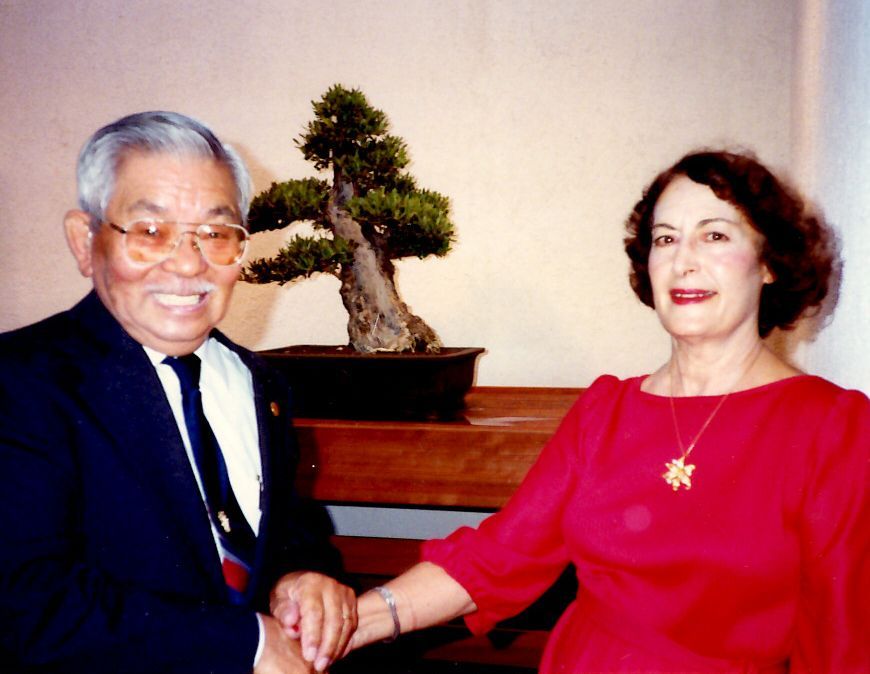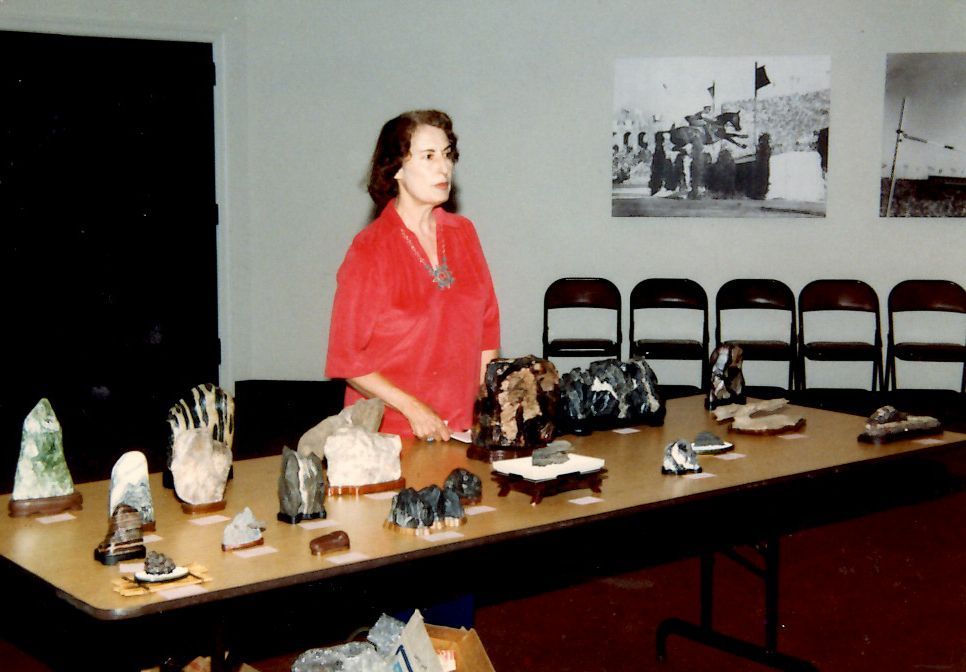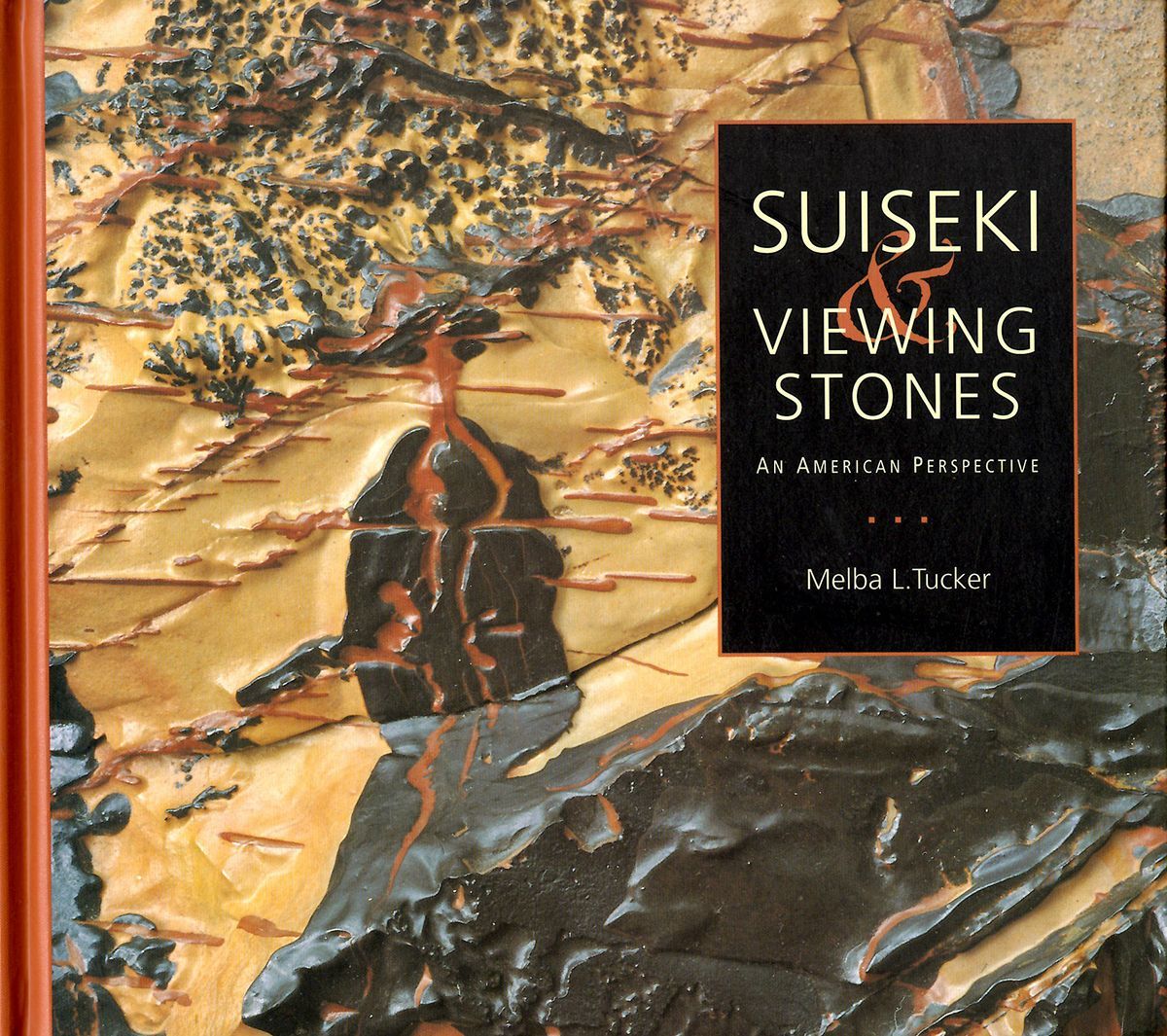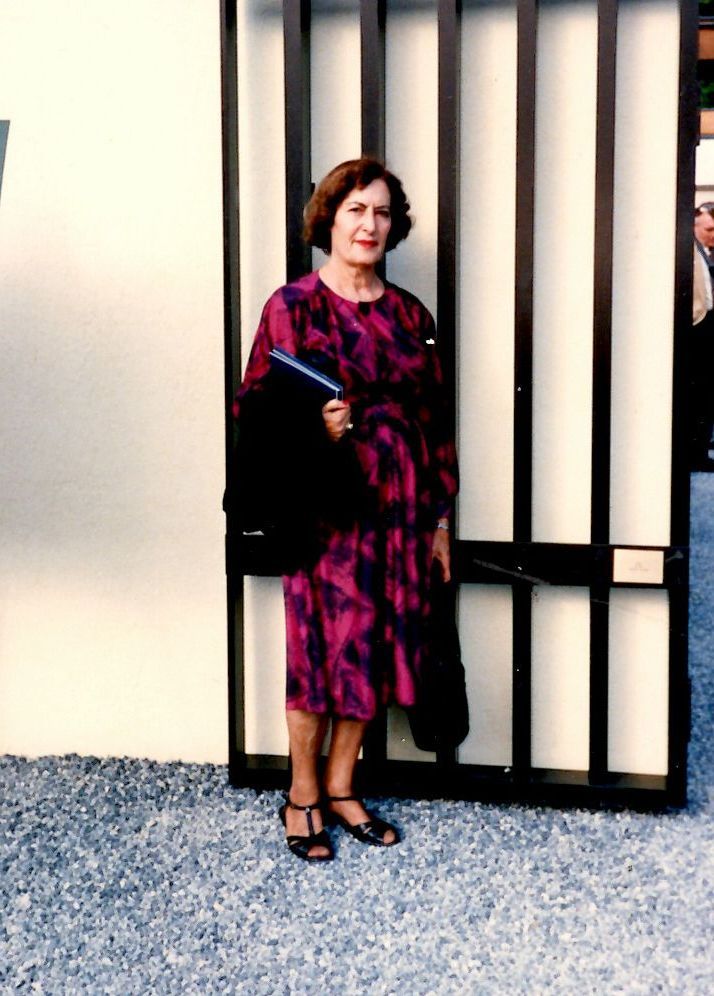North American Viewing Stones: USA
Melba L. Tucker, American Viewing Stone Pioneer
By Thomas S. Elias
By many accounts, Melba L. Tucker (1917-1996), was an extraordinary individual who passionately pursued and promoted the arts of bonsai, saikei, suiseki, and viewing stones. She broke the glass ceiling in North America and led the way for women to actively engage in these art forms. In this article, I will focus primarily on her contributions to the development of stone appreciation.
Melba learned the basics of growing plants early in her life. She was born and raised on a farm in Colorado. After high school, she moved to Los Angeles, where she met and married Ned Tucker. She saw her first bonsai at the San Gabriel Nursery. This piqued her interest. Later, she was given a potted pine tree and wanted to see if she could develop it into a bonsai. Melba studied bonsai techniques with Kahn Komai for several years as she honed her styling techniques and developed her own collection of trees. She fell in love with the art of saikei, often described as living landscapes in miniature, when she observed Kawamoto Toshio create a saikei at a Bonsai Clubs International convention in Kansas City. Kawamoto invented saikei in Japan after the Second World War as an inexpensive alternative to bonsai. He used small trees and stones to create a tray landscape scene and published several books on this subject. Melba quickly mastered this technique and became the leading teacher and creator of saikei in the U.S. She published an article on saikei in the 1974 issue of International Bonsai Digest. An olive saikei she created can be seen in the North American collection in the National Bonsai and Penjing Museum.

Melba Tucker was not only a talented bonsai and viewing stone artist but also worked to promote these art forms throughout her life. She was a founding member of the Santa Anita Bonsai Club, the first female member of the California Bonsai Society, and a founding member of the National Bonsai Foundation. Melba also served on the board of directors of Bonsai Clubs International in the early 1990s. She published several articles on bonsai and stone appreciation. Furthermore, she traveled and taught bonsai, saikei, and stone appreciation in Canada (1978), South Africa (1980), Colombia (1980s), and Australia (1981).
Her interest in the use of small rocks to create a saikei led to her interest in viewing stones. Mary Bloomer (1996) quoted Tucker as saying, “As I worked with rocks in my plants, I became more and more interested in the rocks themselves…in their shapes and textures.” According to Bloomer, Melba purchased several rocks from a stone collector in the early 1970s. That was it. She was hooked on stones and began to search for unusual, aesthetically pleasing stones. This search took her to rivers and mountains in California, but locations in the southern California desert areas were of greater interest. She would go out with Bob Watson and Tony Thomas, two other early stone collectors in California. They would explore remote areas using dune buggies or on foot. Stones found in the Dumont Dunes region in the Mojave Desert yielded many outstanding stones.


“Geisha Girl,”20 cm wide, 15 cm deep, and 22 cm high
In 1983, Melba collected an Indian Blanket stone with a pattern on its face that suggests a Japanese lady in a traditional kimono. She named this Dumont Dunes stone “Geisha Girl.” This is a sedimentary siltstone with many traces of mineral elements that help form the pattern and add additional color to the stone. Ned Tucker carved the base for this stone and for many other stones that Melba collected over several decades.
“Geisha Girl” was gifted to the National Bonsai and Penjing Museum in the U.S. National Arboretum in Washington, D.C. by Melba’s daughter, Mariana Haugh. “Geishi Girl” was featured in the leading book on Japanese suiseki,
The Japanese Art of Stone Appreciation, written by Vincent Covello and Yuji Yoshimura, published in 1984. It was also shown on the cover of the September/October 1994 issue of Bonsai Magazine.
Melba’s waterfall stone, 42 cm wide, 15 cm deep, 17 cm high
Mojave Desert ventifact stones.
Tucker collected numerous small desert ventifact stones, that were formed and polished by sand-laden desert winds since this desert and the southern Sierra Mountains were formed millions of years ago. The Mojave Desert area lies in the rain shadow of these mountains. The shape, form, color, and surface features of these naturally polished rocks can be provocative and suggestive to viewers. They make great American-style viewing stones that are unlike suiseki found in Japan. These ventifacts closely resemble similar rocks found in the Gobi Desert in Asia.
Rock collecting in the Dumont Dunes area of the Mojave Desert, one of Melba’s favorite rock-collecting sites, was restricted when the U.S. Congress passed the California Desert Protection Act on October 31, 1994. Prior to this time, rock collecting for individual use on this land was permitted and was administered by the Bureau of Land Management. Now, these older collecting sites lie within the boundaries of the Mojave Natural Preserve, and collecting rocks is strictly prohibited.

Russian River Distant Mountain Stone, published on page 21 in Melba’s book
Waterfall stone from a California desert, page 18 in Melba’s book.
California Rogue River Puddle Stone, published on page 33 in Melba’s book.

Melba at the U.S. National Arboretum in Washington, D.C., May 1997, where she received a certificate of Appreciation from the U.S. Department of Agriculture for her outstanding contributions to the art of bonsai and for her support of the National Bonsai and Penjing Museum.
Melba published one of the first books of North American stones in 1996. Her Suiseki & Viewing Stones, An American Perspective, featured selected stones from her personal collection. Peter Bloomer photographed the stones, and Horizons West served as the publisher. This volume, featuring many California desert stones, helped to define the scope of stone types comprising a North American stone appreciation concept. Melba L. Tucker was truly a creative, talented pioneer who played a significant part in the early history of stone collectors in the United States. She died on August 26, 1999.
On February 1, 2002, eight members of the California Aiseki-kai club assembled in the Mojave Desert for a small memorial service to honor Melba. These close personal friends of Melba were Peter and Mary Bloomer, Dien and Helen Liang, Bill and Lois Hutchison, Lucille Roberts, and Marge Blasingame. They constructed a small concrete cairn with eight stones embedded in the concrete, one for each person attending this service. An Indian Blanket stone engraved with Melba's name and the date of her birth and death was placed on the top of the cairn. They etched on the wet concrete, “She loved the desert.”
The Melba Tucker Demonstration Area in the Lower Courtyard of the National Bonsai and Penjing Museum was officially dedicated and opened during the 5th World Bonsai Convention in Washington, D.C., in 2005. This museum has fifteen of Melba Tucker's stones in its collection.
Acknowledgments: I want to thank Mariana Haug for supplying considerable information and photographs; Kathleen Emerson Dell for information about Tucker’s stones in the National Bonsai and Penjing Museum; James Greaves for information about her stones at the Huntington Library, Art Museums, and Botanical Gardens; and Dien Liang for personal information and allowing me to photograph some of Tucker’s stones in his collection.
References:
Bloomer, M. 1996. Melba Tucker, America’s First Lady of Bonsai, Sakei & Suiseki. Bonsai Magazine. 35(3): 40-44.
Bloomer, M. 1999. Melba Tucker: 1917-1999, A Celebration of Her Life. Bonsai Magazine. 38(6): 19.
Hutchinson, B. 2001. Melba Tucker, Memorial in the Desert. Golden Statements 24(3):28-29
National Bonsai Foundation. 2000. Awakening The Soul, The National Viewing Stone Collection of the National Bonsai and Penjing Museum at the United States National Arboretum, Washington, D.C. 92 pp.
Tucker, M.L. 1974. Saikei. International Bonsai Digest. Los Angeles, pp. 44-46
Tucker, M. L. 1988. There is a Difference….Bonsai, Suiseki, Bonkei, Bonseki, Saikei. Bonsai Bulletin 25(3):7,8.
Tucker, M. L. 1996. Suiseki & Viewing Stones, An American Perspective. Horizons West, Flagstaff, AZ. 41 pp.
Archived Articles on US Stones
List of Services
-
Stone Images XIIIClick here List Item 1
The Pacific Northwest Viewing Stone Club, a study group within the Puget Sound Bonsai Association, staged their thirteenth exhibition of viewing stones at the Pacific Bonsai Museum in Federal Way, Washington, November 1-8, 2023.
-
The 34th California Aiseki-kai Viewing Stone ExhibitionClick here
The 34th California Aiseki-kai exhibition continued its longstanding reputation December 26-30, 2023, of being the finest display of North American viewing stones held in the U.S.
-
Melba L. Tucker, American Viewing Stone PioneerClick here
By many accounts, Melba L. Tucker (1917-1996), was an extraordinary individual who passionately pursued and promoted the arts of bonsai, saikei, suiseki, and viewing stones.

